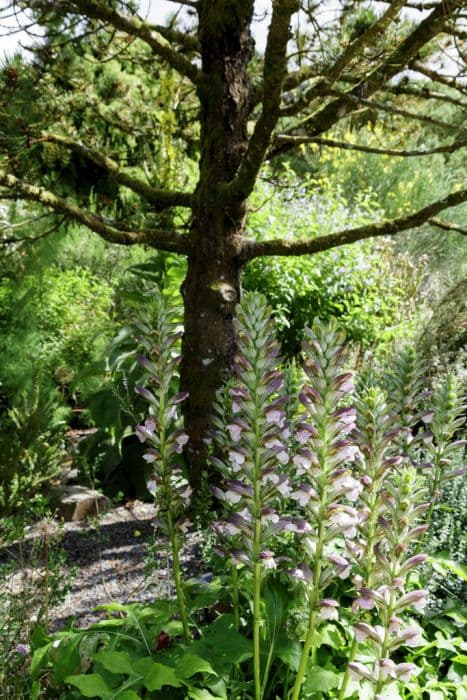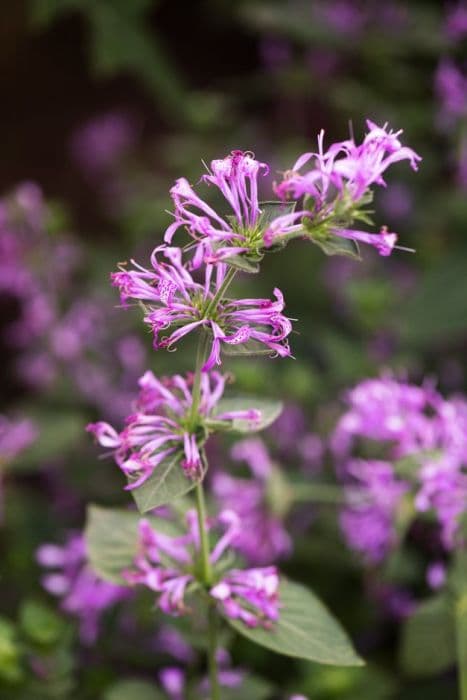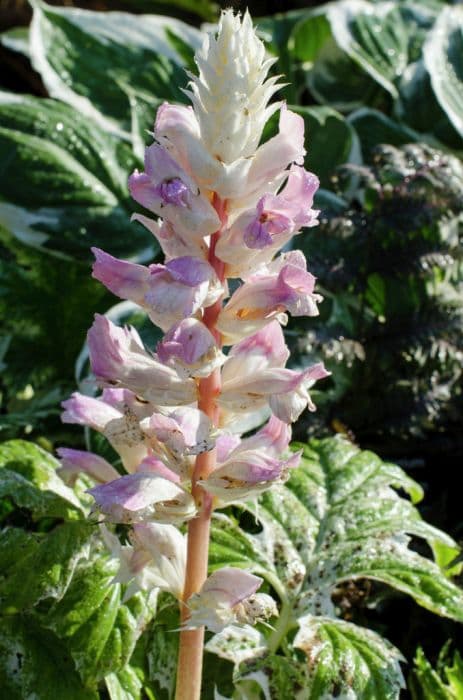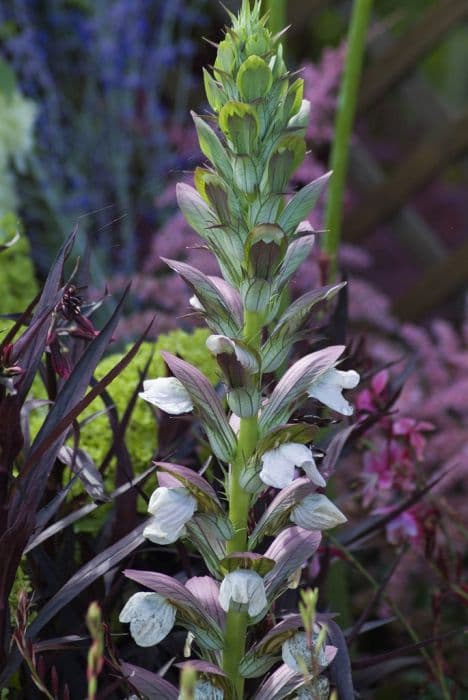Ethiopian Acanthus Acanthus sennii

ABOUT
Acanthus sennii, commonly known as Ethiopian acanthus, is a striking plant known for its bold and architectural appearance. The leaves of Ethiopian acanthus are typically glossy and dark green, with a serrated or spiny edge that can be both visually appealing and slightly intimidating. The texture of the leaves is often leathery, contributing to the plant's robust look. The flowers of the Ethiopian acanthus are another standout feature, with vibrant red to orange blooms that emerge in a spike-like inflorescence. The floral bracts can be quite showy and are usually a reddish-pink color that contrasts strikingly with the flowers themselves. Each individual flower is tubular and elongated, which often attracts pollinators like hummingbirds. The overall appearance of the Ethiopian acanthus is one of drama and distinctiveness, as its foliage and flowers combine to create a visual statement in any garden or natural landscape where it grows. It is typically seen as a specimen plant due to its unique look and the striking blossoms that draw the eye. Its aesthetic ensures that it remains a popular choice for gardeners and landscapers seeking a plant with an exotic feel and vivid, warm colors.
About this plant
 Names
NamesSynonyms
Ethiopian Acanthus, Sennii Acanthus
Common names
Acanthus sennii.
 Toxicity
ToxicityTo humans
While I don't have specific information on Acanthus sennii toxicity to humans, members of the Acanthus genus are generally not known to be toxic when touched. However, consumption of plant parts is generally not recommended as they could potentially cause gastrointestinal discomfort or other issues due to the presence of saponins and other irritating compounds. If someone ingests Acanthus sennii and experiences symptoms such as nausea, vomiting, diarrhea, or abdominal pain, they should seek medical attention.
To pets
As with humans, there is a lack of specific data regarding the toxicity of Acanthus sennii to pets, but the Acanthus genus is not typically considered highly toxic to animals. However, ingestion of Acanthus plants could potentially cause mild to moderate gastrointestinal upset in pets. Symptoms of ingestion may include vomiting, diarrhea, or abdominal discomfort. If a pet ingests this plant and shows any concerning symptoms, it is advised to consult a veterinarian.
 Characteristics
CharacteristicsLife cycle
Perennials
Foliage type
Evergreen
Color of leaves
Green
Flower color
Red
Height
4 feet (1.2 meters)
Spread
2 feet (0.6 meters)
Plant type
Shrub
Hardiness zones
9
Native area
Ethiopia
Benefits
 General Benefits
General Benefits- Erosion Control: Acanthus sennii has strong root systems that are excellent for preventing soil erosion.
- Drought Resistant: This plant is well-suited for dry climates as it can tolerate periods of drought once established.
- Architectural Interest: With its bold spiky leaves and striking flowers, Acanthus sennii adds visual interest to gardens.
- Pollinator Attraction: The flowers are attractive to bees and other pollinators, aiding in the pollination of gardens.
- Low Maintenance: Acanthus sennii typically requires minimal care once established, making it a convenient choice for gardeners.
- Deer Resistance: This plant is not a favorite of deer, reducing the likelihood of damage in areas populated by wildlife.
- Long Blooming Season: It has a relatively long flowering period, providing color and interest in the garden for an extended time.
 Medical Properties
Medical Properties- This plant is not used for medical purposes.
 Air-purifying Qualities
Air-purifying QualitiesThis plant is not specifically known for air purifying qualities.
 Other Uses
Other Uses- In some cultures, Acanthus sennii, commonly known as Ethiopian acanthus, may feature in traditional rituals or ceremonies due to its distinct appearance.
- As an artistic inspiration, the striking leaves of the Ethiopian acanthus can be used in motifs for textiles or wallpapers, following a tradition similar to the ancient Greek and Roman use in architecture.
- In garden design, the Ethiopian acanthus can serve as a structural plant, providing height and texture to ornamental beds and borders due to its large, spiny leaves.
- Its flowers and foliage can be used in floristry, especially in exotic or tropical-themed flower arrangements because of their unique appeal and longevity when cut.
- Home decor may also feature the dried seed heads of the Ethiopian acanthus, which provide an interesting aesthetic when displayed in a vase or as part of a dried bouquet.
- During educational activities, the Ethiopian acanthus can be used as a specimen to study plant adaptation and evolutionary traits among the Acanthaceae family.
- In the culinary arts, while not a common practice, the leaves of Ethiopian acanthus could potentially be used as a natural garnish due to their unique shape, though they are generally not considered edible.
- Horticulturists might cultivate Ethiopian acanthus for breeding purposes, crossing it with related species to create new ornamental hybrids.
- Craftsmen may employ the spiky pattern of its foliage as a stamp or imprint in the creation of nature-inspired pottery and ceramics.
- Photographers and painters might seek out the Ethiopian acanthus as a subject in their work, capturing the interplay of light and shadow on its deeply lobed leaves.
Interesting Facts
 Feng Shui
Feng ShuiThe Acanthus sennii is not used in Feng Shui practice.
 Zodiac Sign Compitability
Zodiac Sign CompitabilityThe Acanthus sennii is not used in astrology practice.
 Plant Symbolism
Plant Symbolism- Endurance and Longevity: The Acanthus plant is known to survive in difficult conditions, symbolizing the ability to endure hardships and sustain for a long time.
- Artistic Inspiration: Historically, the leaves of the Acanthus have been a motif in Greek and Roman art and architecture, signifying inspiration, creativity, and the pursuit of beauty.
- Healing and Protection: In some traditions, Acanthus is associated with healing due to its use in herbal medicine. It can also represent a haven or safe place, as its large leaves provide shelter.
 Water
WaterThe Ethiopian Acanthus should be watered deeply but infrequently, allowing the soil to dry out slightly between waterings. A good rule of thumb is to water every week during active growing seasons such as spring and summer, tapering off to every two weeks or as needed during cooler weather. When watering, aim to provide about 1 to 1.5 gallons per plant depending on the size and the container it's in. It's important to avoid waterlogging, as this can lead to root rot. Ensure the plant has proper drainage in place.
 Light
LightThe Ethiopian Acanthus thrives best in full sun to partial shade. For optimal growth, place it in a spot where it will receive at least six hours of sunlight daily. If you're growing the plant indoors, a south-facing window is ideal. However, in extremely hot climates, some afternoon shade can help prevent scorching of the leaves.
 Temperature
TemperatureThe Ethiopian Acanthus prefers a relatively warm climate and does not tolerate extreme cold well. It can endure temperatures down to about 25 degrees Fahrenheit, but frost may damage the foliage. For ideal growing conditions, maintain an ambient temperature between 60 and 75 degrees Fahrenheit. Make sure to protect the plant from freezing temperatures by moving it indoors or providing insulation if it's planted outside.
 Pruning
PruningPrune the Ethiopian Acanthus to maintain shape and health. Deadheading spent flowers encourages further blooming. Pruning should be done in late winter or early spring before the new growth starts. Cut back the foliage to ground level if it's damaged by frost or to refresh the plant annually. This also helps promote vigorous growth and a more abundant bloom in the following season.
 Cleaning
CleaningAs needed
 Soil
SoilThe Ethiopian Acanthus prefers a well-draining soil mix with a pH between 6.0 and 7.5. A mixture of loamy garden soil, peat or coco coir, and perlite or sand aids in appropriate drainage and aeration. Regularly test soil pH and adjust accordingly to maintain the ideal range for healthy growth.
 Repotting
RepottingEthiopian Acanthus should be repotted every two to three years, or when it outgrows its current pot. Choose a container that is one size larger than the previous one to provide enough space for root growth. Best done in the spring or early summer.
 Humidity & Misting
Humidity & MistingEthiopian Acanthus thrives in an environment with average humidity. While it can tolerate some drought, it does best in humidity levels of 40-60%, common in many indoor settings without the need for additional humidity control.
 Suitable locations
Suitable locationsIndoor
Place Ethiopian Acanthus in bright, indirect light and maintain room temp.
Outdoor
Plant in partial shade, shelter from strong winds, enrich soil, water as needed.
Hardiness zone
7b-10 USDA
 Life cycle
Life cycleAcanthus sennii, commonly known as Ethiopian Acanthus, begins its life cycle as a seed, which germinates in warm, moist soil. Upon sprouting, the seedling develops a rosette of spiny, glossy green leaves. As a perennial, it then enters a vegetative growth phase, maturing and forming a robust clump with tall flowering stalks. The flowers are reddish-orange and bloom in the summer, attracting pollinators such as bees. After pollination, the flowers produce seed capsules which, when mature, release seeds to start a new generation. In the right conditions, the Ethiopian Acanthus may also propagate vegetatively through root division.
 Propogation
PropogationPropogation time
Spring-Early Summer
Propogation: The most popular method for propagating Acanthus sennii, commonly known as Ethiopian Acanthus, is by seed. Sowing can be done in late winter to early spring, once the risk of frost has passed. The seeds should be sown in a well-draining soil mix, about a quarter inch (6 mm) deep, and kept moist until germination, which typically takes a few weeks. It's important to provide warmth and light, but not direct sunlight, which can scorch the seedlings. Once the seedlings have developed a few true leaves, they can be transplanted into individual pots and later transferred outside when they are strong enough to withstand outdoor conditions.








